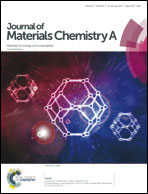A long-life rechargeable Al ion battery based on molten salts†
Abstract
Affordable and scalable energy storage systems are necessary to mitigate the output fluctuation of an electrical power grid integrating intermittent renewable energy sources. Conventional battery technologies are unable to meet the demanding low-cost and long-life span requirements of a grid-scale application, although some of them demonstrated impressive high energy density and capacity. More recently, the prototype of an Al-ion battery has been developed using cheap electrode materials (Al and graphite) in an organic room-temperature ionic liquid electrolyte. Here we implement a different Al-ion battery in an inorganic molten salt electrolyte, which contains only an extremely low-cost and nonflammable sodium chloroaluminate melt working at 120 °C. Due to the superior ionic conductivity of the melt electrolyte and the enhanced Al-ion interaction/deintercalation dynamics at an elevated temperature of 120 °C, the battery delivered a discharge capacity of 190 mA h g−1 at a current density of 100 mA g−1 and showed an excellent cyclic performance even at an extremely high current density of 4000 mA g−1: 60 mA h g−1 capacity after 5000 cycles and 43 mA h g−1 capacity after 9000 cycles, with a coulombic efficiency constantly higher than 99%. The low-cost and safe characteristics, as well as the outstanding long-term cycling capability at high current densities allow the scale-up of this brand-new battery for large-scale energy storage applications.


 Please wait while we load your content...
Please wait while we load your content...